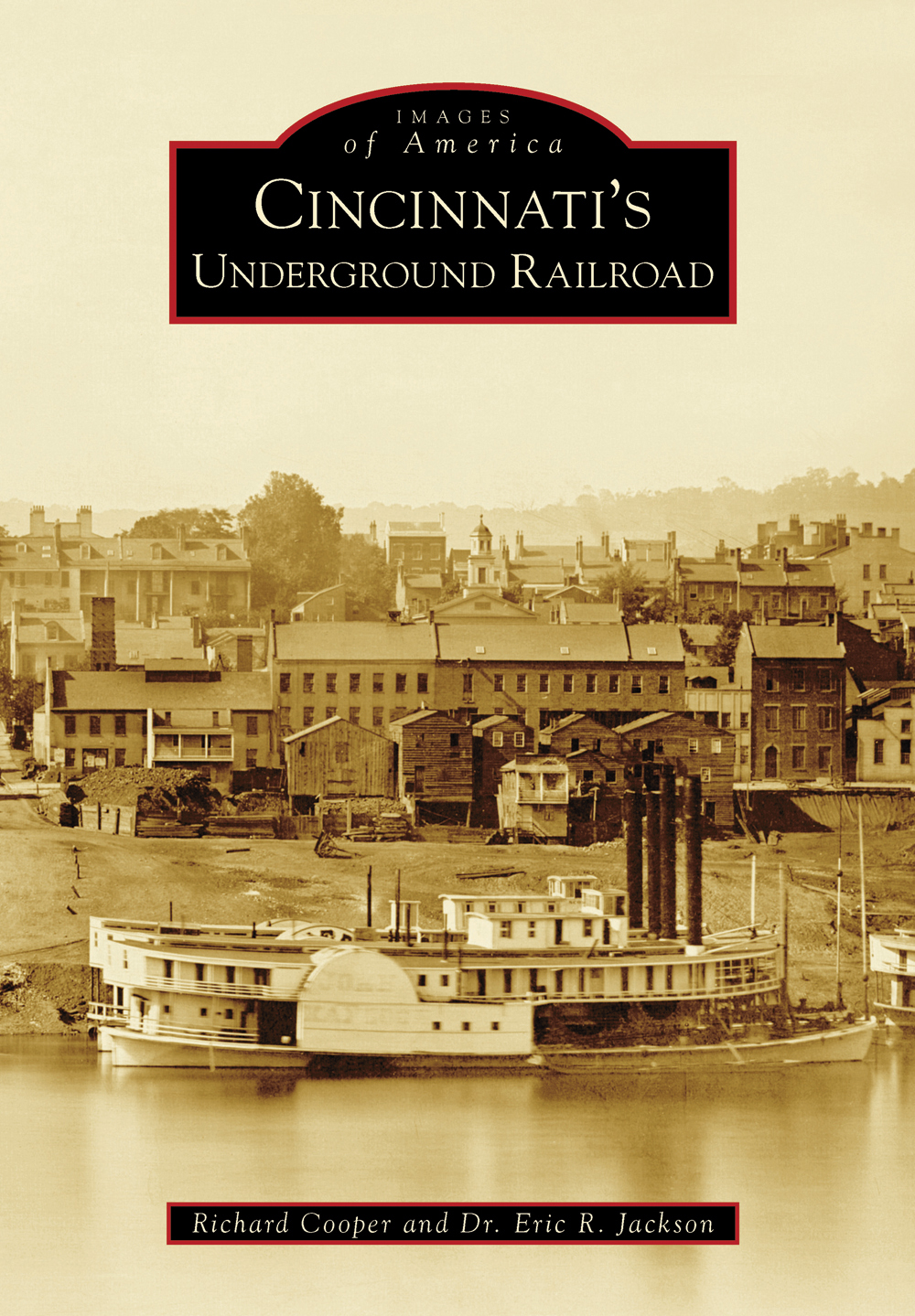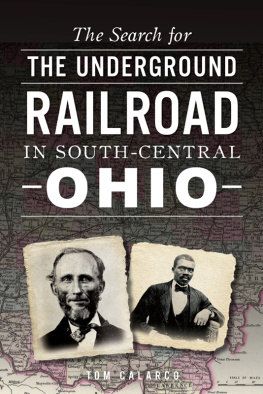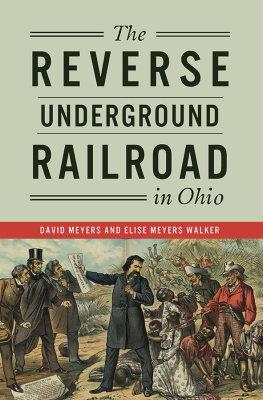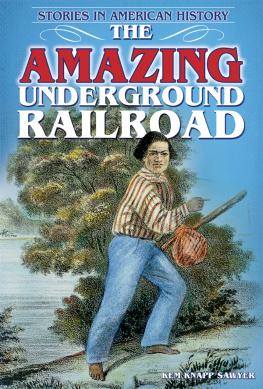
IMAGES
of America
CINCINNATIS
UNDERGROUND RAILROAD
ON THE COVER: This 1848 daguerreotype of Cincinnati was taken by Charles Fontayne and William Porter. By this time, the city of Cincinnati had become the gateway to freedom. (Courtesy of the Public Library of Cincinnati and Hamilton County.)
IMAGES
of America
CINCINNATIS
UNDERGROUND RAILROAD
Richard Cooper and Dr. Eric R. Jackson

Copyright 2014 by Richard Cooper and Dr. Eric R. Jackson
ISBN 978-1-4671-1156-0
Ebook ISBN 9781439644614
Published by Arcadia Publishing
Charleston, South Carolina
Library of Congress Control Number: 2013947908
For all general information, please contact Arcadia Publishing:
Telephone 843-853-2070
Fax 843-853-0044
E-mail
For customer service and orders:
Toll-Free 1-888-313-2665
Visit us on the Internet at www.arcadiapublishing.com
This volume is dedicated to the memories of all those individuals who sought to escape bondage throughout the history of the United States as well as those who continue to work for freedom and equality everywhere today.
CONTENTS
ACKNOWLEDGMENTS
We could not have completed this project without the encouragement, support, and assistance of numerous individuals. We are greatly indebted and give much thanks to our editors Jill Nunn and Mary Margaret Schley. Their patience, understanding, and vision greatly inspired us to continue in the process despite the hardships that were encountered in the acquisition of various items. There is no question that without Jill and Mary Margaret, this book would not have been published with such precision and care.
There are many other people and institutions we also wish to thank for their valuable contributions to the research and completion of this book. We always will be thankful for Linda Bailey, Claire Smittle, and Anne Shepard at the Cincinnati Historical Society-Library as well as Jamie Glavic and Lily Birkhimer at the Ohio Historical Society. Many of the photographs and other resources obtained from these facilities played a very critical role in the development and completion of this volume. We also would like to thank various staff members of the CincinnatiHamilton County Public Library as well as Mike Miller at the Carolina Digital Library and Archives. Special thanks also must go to Northern Kentucky University, particularly Drs. Bill Landon, Brian Hackett, and Paul Tenkotte for their professional support and guidance as this project was developed.
The preparation and writing time needed to complete this book was far beyond what we had anticipated. Thus, we will be forever thankful to a number of people for welcoming us into their offices and institutions to discuss this project hundreds of times, such as Dina Bailey, Cori Sisler, and Carl Westmoreland of the National Underground Railroad Freedom Center, as well as the financial support of the US Department of Education. We will be forever in your debt.
It is impossible to thank all the individuals whose personal strength, everlasting support, and unlimited patience helped us produce this book. However, the most important people are Erics wife, B.J. Jackson, and Richs parents, Marie and Richard Cooper. Much love and thanks goes to you all.
INTRODUCTION
The waters of the Ohio River provided a real and complex barrier for the young nation for nearly a century after the American Revolution ended. On one hand, this waterway symbolized, in general, freedom for thousands of enslaved African Americans who had absconded from their horrible life as a worker on a plantation. On the other hand, the Ohio River was used to transport thousands of enslaved persons of color down the river to the deep South and into a life that was dominated by the Cotton Belt market. In essence, the Ohio River (or as some people called it, the River Jordan) signified both freedom and slavery simultaneously. The paradox that played out along the Ohio also helped to foster a number of cities and towns that became linked to the origin, development, and legacy of the Underground Railroad. One such city was Cincinnati, known by some as Porkopolis or the Queen City. During the antebellum period, because of its location on the Ohio River, as well as the growth of a strong local African American community, the city became a major destination for thousands of individuals who sought to gain their freedom through the use of the Underground Railroad.
This book seeks to document and illustrate this story from a variety of perspectives by examining specific individuals, neighborhoods, organizations, and businesses. For example, on a peaceful evening in 1842, John P. Parker quietly boarded a ship that was docked in the harbor of New Orleans. Scared but determined, Parker knew that his days as an enslaved African American were numbered. Several hours later, the vessel set sail up the Mississippi River with Parker safely hidden on board. Along the way, young John admired the scenery as if he was a passenger on an ocean cruise. This latest attempt to gain his freedom brought Parker to New Albany, Indiana, Cincinnati, and eventually Ripley, Ohio. Once in Ripley, Parker, along with Rev. John Rankin, began to assist thousands of other black Americans on their journey to freedom.
Several years earlier, in 1838, Frederick Douglass (formerly known as Frederick Augustus Washington Bailey) took flight from his Baltimore, Maryland, plantation. After much planning, young Douglass began his journey to freedom when he acquired a set of free papers from an African American sailor he had known for several months. Using forged free papers, Douglass eventually was able to board a train headed to Philadelphia. As the train began to move down the tracks, a sense of excitement fell upon him. However, this feeling quickly disappeared when he became involved in an unexpected conversation with a free African American passenger. Douglass began to think that his time as a fugitive was about to end. However, after a close call with the approaching ticket-taker that could have revealed his identity, Douglass safely continued north to Philadelphia, New York City, and eventually Boston.
About a decade later, Ellen and William Craft devised a secret but dangerous plan to escape from enslavement in Georgia. On a bright morning, Ellen awoke and began to dress in clothes that made her look like a white slave owner. Several minutes later, William, her husband, appeared as Ellens African American slave. The two of them quickly packed some items and left their plantation. Although neither Ellen nor William could not read or write, their plan worked almost perfectly.
Several months later, in September 1844, Lewis Hayden and his family escaped from slavery in Lexington, Kentucky. However, Delia Webster and Calvin Fairbanks, the young white couple who aided them, in some ways came to be far better known then Hayden. During a five year period, Webster and Fairbanks helped hundreds of African Americans escape bondage throughout the Bluegrass state. However, their fame worked against them when the two were arrested in 1844 on their way to Lexington to help free more enslaved African Americans. Webster was sentenced to two years in prison, while Fairbanks was sentenced to five to fifteen years in the state penitentiary. He severed his time until Kentucky governor John Crittendon pardoned him on August 28, 1849.
The journeys, comments, and activities of Parker, Douglass, the Crafts, Delia Webster, Calvin Fairbanks, and thousands of others illustrate that the path to freedom was hard, complex, long, mysterious, terrifying, and dangerous, but it was still worth the sacrifice for those who were willing to try anything to obtain freedom. This quest became more difficult with the end of the American Revolution, the ratification of the US Constitution, and the implementation of the Fugitive Slave Acts of 1793 and 1850. Despite these laws and decrees, thousands of people, African Americans and Caucasians, rich and poor, Christians and non-Christians, came together to help black American fugitives gain their freedom. Thanks to Congressional actions and National Park Service initiatives of the 1990s, as well as the opening of the National Underground Railroad Freedom Center in 2004, this history remains alive in the minds of many Americans.
Next page









